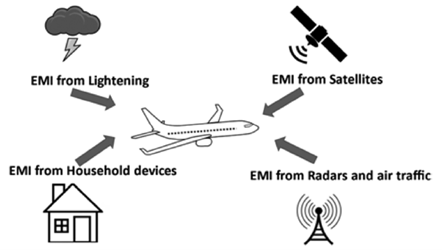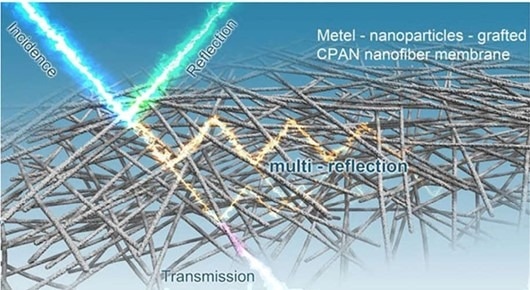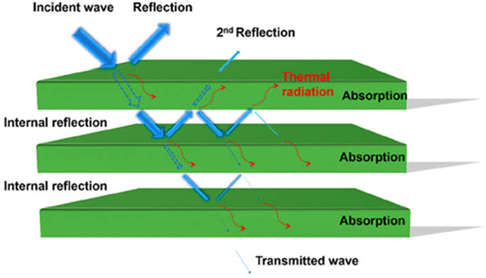Authors; Melike Gozutok, Abdullah Aslamaci
In the context of an increasingly interconnected and wireless world, the proliferation of electronic devices and communication systems has led to an unprecedented rise in electromagnetic radiation. While this advancement has revolutionized various industries and enabled seamless connectivity, it has also given rise to concerns about potential health risks and interference with sensitive electronic equipment. Here electromagnetic shielding comes to the forefront as a critical technology to safeguard against unwanted electromagnetic interference (EMI) 1.
Figure 1. EMI mechanism 1. Image Credit: Inovenso
Definition
Electromagnetic shielding refers to the use of materials or structures to block or reduce the electromagnetic radiation that can be emitted or received by electronic devices or systems. Here are a few common applications of electromagnetic shielding:
- Electronics: Electronic devices such as smartphones, laptops, and tablets contain sensitive components that can be affected by electromagnetic interference (EMI). Electromagnetic shielding helps protect these devices by blocking or redirecting external electromagnetic radiation. It ensures that the electronic components work properly without interference.
- Medical Equipment: In the medical field, electromagnetic shielding is crucial for sensitive medical equipment such as MRI machines, pacemakers, and defibrillators. Shielding prevents external electromagnetic radiation from interfering with the accuracy and functionality of these devices, ensuring they work safely and effectively.
- Aerospace and Aviation: Electromagnetic shielding is essential in aerospace and aviation industries. It helps protect sensitive electronic systems in aircraG and spacecraG from external electromagnetic interference, which could disrupt communication systems, navigation equipment, and other critical electronic systems.

Figure 2. Schematic Diagram of Different Sources of EMI in aerospace 2. Image Credit: Inovenso
- Automotive: Modern vehicles are equipped with various electronic systems, including communication, navigation, and entertainment systems. Electromagnetic shielding is used to minimize interference from external electromagnetic radiation sources such as radio signals or electrical equipment, ensuring optimal performance of these systems.
- Telecommunications: Telecommunication infrastructure, including cellular towers and base stations, rely on electromagnetic shielding to prevent interference from nearby electronic devices or radio signals. Shielding ensures that the transmission and reception of signals remain clear and uninterrupted.
It’s important to note that electromagnetic shielding can be achieved using different materials, such as conductive metals like copper or aluminum, and specialized coatings or composites designed to block specific frequencies of electromagnetic radiation 2.
Electrospinning for EMI
Electrospinning is a versatile technique that can be utilized for various applications, including electromagnetic shielding. Electrospinning involves the creation of nanofibers by applying an electric field to a polymer solution. These nanofibers have a high surface area-to-volume ratio, which makes them suitable for electromagnetic shielding applications 3.

Figure 3. Electrospinning Process. Image Credit: Inovenso
Here’s how electrospinning can be used for electromagnetic shielding:
It is possible to make a selection of conductive materials: Electrospinning allows for the deposition of conductive materials in the form of nanofibers. Conductive polymers, such as polyaniline or polypyrrole, or carbon-based materials like carbon nanotubes or graphene, can be electrospun into nanofibers. These conductive nanofibers can provide efficient pathways for the dissipation or absorption of electromagnetic radiation.
Electrospinning can also be used to create composite nanofibers by incorporating conductive fillers, such as metal nanoparticles or metal-coated nanoparticles, into polymer solutions. These composite nanofibers combine the beneficial properties of both the conductive fillers and the polymer matrix, enhancing the electromagnetic shielding effectiveness.
Electrospinning process allows us to use layered structures, : Electrospun nanofibers can be stacked or assembled into multilayer structures to improve the electromagnetic shielding performance. By alternating layers of conductive and insulating nanofibers, a barrier is created that reflects, absorbs, or dissipates electromagnetic waves, thereby reducing their impact on sensitive electronic devices.
Different specialties can be given to the product. Production of customized shielding performance is possible that electrospinning allows for the control of nanofiber properties, such as diameter, alignment, and composition. By optimizing these parameters, the electromagnetic shielding effectiveness can be tailored to specific requirements, such as shielding a particular frequency range or meeting specific performance standards.
nanofibers are inherently flexible and lightweight, making them suitable for integration into flexible or lightweight electronic devices. These nanofibers can be incorporated into wearable electronics, flexible circuit boards, or electromagnetic interference (EMI) shielding films, providing efficient shielding while maintaining the device’s flexibility and portability.

Figure 4. Example of an electrospun structure as an EMI 12. Image Credit: Inovenso
It is noteworthy to mention that the utilization of electrospinning technique for the purpose of electromagnetic shielding is an area of research that is presently gaining much a1ention. Additionally, there are continued efforts towards improving the performance and practicality of electrospun electromagnetic shielding materials, through the exploration of advanced materials, designs, and manufacturing processes 4.
Polymer Selection
When considering polymers for electrospinning in electromagnetic shielding applications, several factors should be taken into account, including conductivity, mechanical properties, processability, and compatibility with other materials. Here are some candidate polymers commonly used for electrospinning in electromagnetic shielding applications:
- Conductive Polymers: Polymers with inherent conductivity or the ability to be made conductive are oGen utilized for electromagnetic shielding. Examples include:
- Polyaniline (PANI): PANI is a widely studied conductive polymer with good electrical conductivity. It can be electrospun to produce nanofibers suitable for electromagnetic shielding 7.
- Polypyrrole (PPy): PPy is another conductive polymer commonly used for electrospinning. It offers good conductivity and can be incorporated into nanofiber structures for shielding applications.
- Carbon-Based Materials:
- Carbon Nanotubes (CNTs): CNTs possess excellent electrical conductivity and can be electrospun either as individual nanofibers or as composite materials with polymers. They enhance the electromagnetic shielding properties of the resulting nanofibers.
- Graphene: Graphene, a single layer of carbon atoms, exhibits exceptional electrical conductivity. Electrospinning techniques can be employed to create nanofibers containing graphene, leading to improved electromagnetic shielding effectiveness 5.
- Blends and Composites:
- Polymer/Carbon Nanofiber Composites: Blending polymers with conductive carbon nanofibers (such as carbon nanotubes or graphene) can yield composite nanofibers with enhanced electromagnetic shielding capabilities 6.
- Polymer/Metal Nanoparticle Composites: Incorporating metal nanoparticles (e.g., silver, copper) into polymer matrices can produce composite nanofibers that exhibit improved electrical conductivity and shielding efficiency 8-9.
- Other Polymers:
- Polyacrylonitrile (PAN): PAN is a versatile polymer oGen used as a precursor for carbon nanofibers. It can be electrospun and subsequently carbonized to create electrospun carbon nanofibers suitable for electromagnetic shielding.
- Polyurethane (PU): PU is known for its excellent mechanical properties and processability. It can be electrospun alone or blended with other conductive materials to produce nanofibers with suitable shielding properties.
The selection of the most appropriate polymer depends on specific requirements, such as the desired conductivity, mechanical strength, flexibility, and compatibility with other materials or fabrication processes. It’s important to consider the target application and the overall performance objectives when choosing a polymer for electrospinning in electromagnetic shielding applications 10.
Applications and Examples
Electrospun nanofibers have found numerous applications in electromagnetic shielding due to their unique properties. Here are some examples of electrospun shielding applications:
- Electromagnetic Interference (EMI) Shielding Films: Electrospun nanofibers can be integrated into films or coatings to provide EMI shielding. These films are used to shield electronic devices or sensitive components from external electromagnetic radiation. The electrospun nanofibers create a barrier that absorbs or reflects electromagnetic waves, preventing interference.
- Conductive Textiles: Electrospinning can be employed to produce conductive nanofiber coatings on textiles or fabrics. These conductive coatings provide EMI shielding properties to the textiles, making them suitable for applications such as electromagnetic shielding garments, RFID-blocking fabrics, or flexible circuits in wearable electronics.
- Transparent EMI Shielding Films: Transparent conductive coatings or films are oGen required for electronic displays or touchscreens. Electrospinning can be utilized to create transparent conductive nanofiber films that offer EMI shielding while maintaining optical clarity. These films find applications in smartphones, tablets, and other display devices.
- Shielding of Cables and Wires: Electrospun nanofiber coatings can be applied to cables and wires to enhance their electromagnetic shielding capabilities. The nanofiber coatings effectively block or redirect electromagnetic radiation, reducing crosstalk and interference in electrical wiring systems.
- Packaging Materials: Packaging materials for sensitive electronic devices or components may require electromagnetic shielding to prevent damage or interference during transportation. Electrospun nanofiber-based packaging materials can provide effective EMI shielding to protect the enclosed electronic devices from external electromagnetic radiation.
- Antenna Design: Electrospun nanofibers can be utilized in the design and fabrication of antennas for enhanced performance. By incorporating conductive nanofibers, such as carbon nanotubes or metal-coated nanofibers, into the antenna structure, the radiation efficiency can be improved, resulting in better signal reception and transmission.
An interesting paper by Kim et al 11 focuses on the development of a novel ultra-thin radiation- shielding paper inspired by the unique structure of the wings of the Morpho butterfly. The researchers aimed to create a lightweight and flexible material that could effectively block radiation while maintaining high transparency.
The study begins with a detailed examination of the Morpho butterfly wing structure, which exhibits a distinctive hierarchical pattern of micro- and nano-scale features. The researchers used this natural structure as a blueprint for designing nanofiber-based materials for radiation shielding. Through a combination of experimental techniques and computational modeling, the researchers successfully replicated the Morpho butterfly wing structure using electrospun nanofibers. This technique allowed them to create thin paper-like materials with a similar hierarchical pattern of layers.
The fabricated nanofiber-based radiation-shielding paper demonstrated excellent performance in blocking harmful radiation. The hierarchical structure of the nanofibers effectively dispersed and attenuated radiation waves, providing a high level of shielding efficiency.
Furthermore, the ultra-thin nature of the paper made it highly flexible and lightweight, making it suitable for a wide range of applications. The material’s transparency was also preserved, allowing for its integration into devices or systems where visibility is crucial.
The findings of this study hold significant promise for the development of advanced radiation- shielding materials. The bio-inspired approach, using the Morpho butterfly wing structure as a model, opens up possibilities for the design and fabrication of innovative materials with unique properties for various radiation-blocking applications.
In conclusion, the article presents a successful exploration of nanofiber modeling based on the Morpho butterfly wing structure, leading to the development of ultra-thin radiation-shielding paper with excellent shielding performance, flexibility, and transparency. The research highlights the potential of bio-inspired approaches in material design and paves the way for future advancements in radiation protection technology 11.
These are just a few examples of how electrospun nanofibers are used in electromagnetic shielding applications. The versatility of electrospinning allows for the integration of nanofibers into various forms, such as films, coatings, or composite materials, to achieve effective electromagnetic shielding in different industries and technologies.
References
- Bai, M., Zheng, G., Zhang, L., Ma, S., Yang, X., & Zhang, X. (2017). A facile method to prepare electrospun polymer nanofibers for electromagnetic interference shielding. Materials Letters, 200, 23-26.
- Jang, W. Y., Lee, K. H., An, S. H., Kim, M. J., & Kim, C. H. (2019). Fabrication and characterization of magnetic electrospun nanofibers for efficient electromagnetic interference shielding. Composites Part B: Engineering, 174, 106956.
- Zhang, B., Wang, L., & Yang, J. (2020). Electrospun nanofibers reinforced conductive polymer composites for electromagnetic interference shielding. Composites Part A: Applied Science and Manufacturing, 129, 105700.
- Yuan, Y., Zhang, Y., Li, L., Shi, C., Zhang, Y., & Zhang, H. (2019). Electrospun polymer nanofibers decorated with metal nanoparticles for efficient electromagnetic interference shielding. Polymer Engineering & Science, 59(7), 1355-1362.
- Wang, Y., Yang, Z., Wang, F., Zeng, Y., Gu, Y., & Wei, Q. (2019). Graphene-based nanocomposites for electromagnetic interference shielding. Small, 15(47), 1902621.
- Nian, Q., Hu, Y., Wang, J., Yao, H., Jiang, L., & Zhang, K. (2020). One-step fabrication of electrospun nanofibers loaded with multi-walled carbon nanotubes for high-performance electromagnetic interference shielding. Composites Science and Technology, 189, 108015.
- Chen, H., Zhu, B., Xia, Z., Xu, C., Wu, D., Gu, M., … & Ding, Y. (2018). Flexible and conductive nanocomposite films with high electromagnetic interference shielding effectiveness based on electrospun polyaniline/multi-walled carbon nanotube/silver-coated carbon fiber. Composites Science and Technology, 156, 297-306.
- Wang, J., Chen, H., Sun, X., Ma, M., & Zhang, Y. (2018). Facile fabrication of electrospun polyacrylonitrile/carbon nanotube composite nanofibers with high electromagnetic interference shielding effectiveness. Carbon, 129, 135-142.
- Quan, B., Liu, W., Jia, Z., Wang, M., Zhou, C., & Song, Y. (2020). In situ generation of Ag nanoparticles in electrospun polyacrylonitrile fibers for lightweight and flexible electromagnetic interference shielding. Composites Science and Technology, 196, 108201.
- Li, J., Zhang, L., Li, M., Wang, H., Zhang, Y., & Li, J. (2020). Lightweight, flexible, and high electromagnetic interference shielding efficiency film based on electrospun PVDF/CNT/MXene. Composites Science and Technology, 187, 107957.
- Kim, S.C., Byun H. (2022). Development of ultra-thin radiation-shielding paper through nanofiber modeling of morpho butterfly wing structure. Scientific Reports, 12, 22532
- Ji, H., Zhao, R., Zhang, N. et al. Lightweight and flexible electrospun polymer nanofiber/metal nanoparticle hybrid membrane for high-performance electromagnetic interference shielding. NPG Asia Mater 10, 749–760 (2018)
This information has been sourced, reviewed and adapted from materials provided by Inovenso.
For more information on this source, please visit Inovenso.



